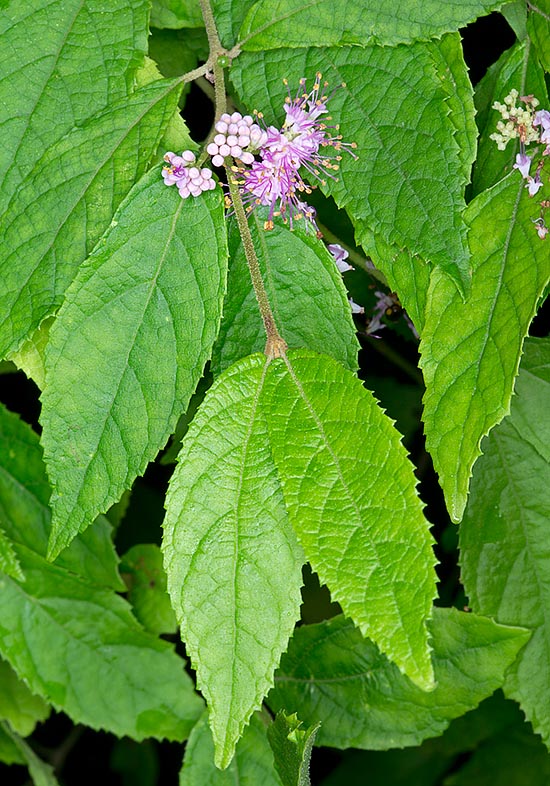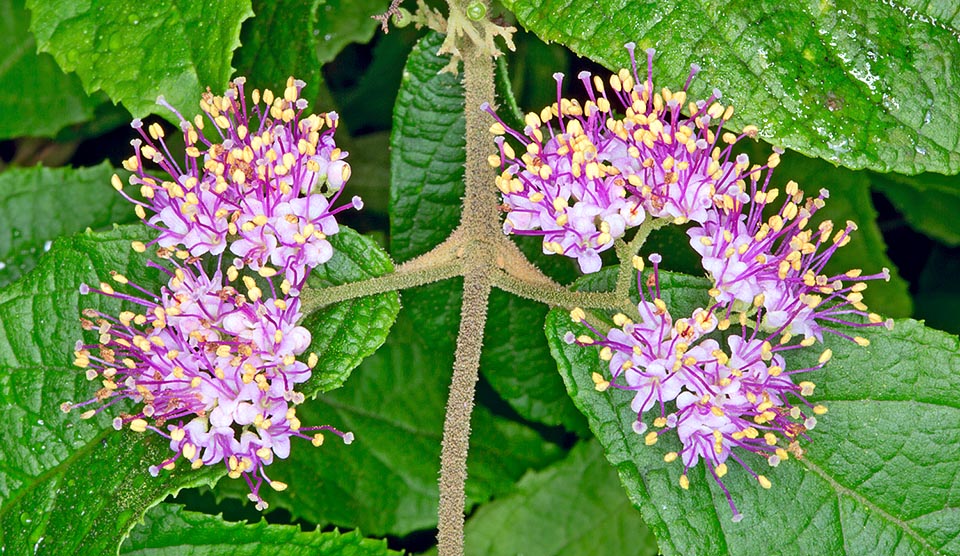Family : Lamiaceae

Text © Pietro Puccio

English translation by Mario Beltramini

At home in South-East Asia up to Australia, Callicarpa pedunculata is a 1-4 m tall shrub © G. Mazza
The species is native to Assam, Australia (New South Wales and Queensland), China (Guangdong), Sikkim, Indonesia (Java, Moluccas Islands, Sulawesi and Sumatra), Malaysia (Pahang, Penang and Sabah), Myanmar, New Guinea and East Timor where it grows at the margins of the forests and in the prairies, from the sea level up to more than 1000 m of altitude.
The generic name is the combination of the Greek substantives “κάλλος” (kallos) = beauty and “καρπός” (karpos) = fruit, with obvious reference; the specific name is the Latin adjective “pedunculatus, a, um” = equipped with peduncle, with reference to the peduncle of the inflorescences longer than the petioles.
Common names: beauty berry, velvet leaf (English); tzu-chu ts’ao, tzu-chu shu (Chinese); memeniran, meniran, ringan-ringan (Indonesian).
The Callicarpa pedunculata R.Br. (1810) is a 1-4 m tall shrub with stems and branches densely covered by stellate hairs of fawn or rust colour.
The leaves, on a 0,5-1 cm long petiole covered by a brown-yellowish tomentum, are opposite, simple, ovate-elliptic with long pointed apex and toothed margins, 6-16 cm long and 4-6 cm broad, covered above by a slight hairness, below thickly covered by stellate hairs of brown-yellowish colour and dotted by resinous glands.
The inflorescences are dichotomous axillar cymes, on a tomentose peduncle longer than the petiole, 0,8-2,5 cm, globose, of 3-5 cm of diameter, carrying numerous bisexual flowers with campanulate calyx with 4 triangular lobes, 1-1,5 mm long, covered outside by stellate glandular hairs, glabrous imbutiform corolla of pale purple colour, 2,5-3 mm long, with 4 about 1 mm long and broad lobes, 4 stamens 4-6 mm long and 5-8 mm style.
The fruits are globose drupes of violet purple colour when ripe, of about 2-4 mm of diameter, containing 4 woody pyrenes (stones), each one with only one ellipsoid, 1,2 mm long seed.
It reproduces by seed, in sandy loam rich of organic substance maintained humid at the temperature of 20-24 °C, with germination times of 1-3 months, and by semi-woody cutting. Fast growing species cultivable in the tropical subtropical and warm temperate climate regions, where it can resist to temperatures up to about -5 °C. It grows preferably in full sun or filtered sun light on draining soils, rich, slightly acidic to slightly alkaline, maintained moderately humid. It is utilized for ornamental purposes to realize mixed edges and fences, and in gardens for butterflies, with frequent prunings in order to maintain compact the posture.

Born for warm climates, even if resists to -5 °C, attracts butterlies and adapts to prunings for dense fences. Leaves, roots and young branches have medicinal virtues © Giuseppe Mazza
It can be cultivated in pot with loam rich of organic substance, with addition of siliceous sand or perlite per a 30% to improve the drainage, with regular waterings, but without stagnations, during the vegetative period, more reduced in winter, but without ever allowing the substratum to dry up completely. The fertilizations, in spring summer, are to be done preferably with products rich of phosphorus and potassium in order to stimulate blooming and fructification.
Leaves, roots and young branches are variously utilized in the traditional medicine of the local populations as analgesic, anti-inflammatory, aniphlogistic and haemostatic.
Synonyms: Callicarpa cuspidata Roxb. (1820); Callicarpa dentata Roth (1821); Callicarpa tiliifolia Teijsm. & Binn. ex C.B.Clarke (1885); Callicarpa viridis Domin (1928).
Some botanists consider its synonym also the Callicarpa formosana Rolfe (1882).
→ To appreciate the biodiversity within the family LAMIACEAE please click here.
